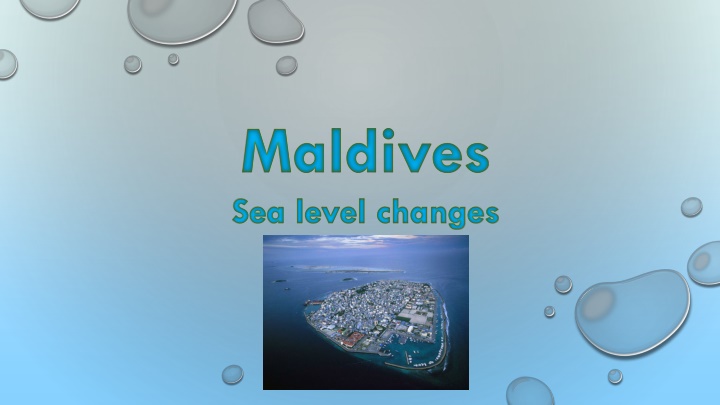Addressing Sea Level Changes in the Maldives
The Maldives, a group of coral islands in the Indian Ocean, faces imminent threats from rising sea levels. With 80% of its islands less than 1m above sea level, 360,000 citizens might need to evacuate in the next 100 years. The impacts include forced migration, economic decline, and environmental degradation, particularly affecting coral reefs. Solutions being considered range from sea walls and artificial islands to education and legislation to protect their natural resources.
Download Presentation

Please find below an Image/Link to download the presentation.
The content on the website is provided AS IS for your information and personal use only. It may not be sold, licensed, or shared on other websites without obtaining consent from the author.If you encounter any issues during the download, it is possible that the publisher has removed the file from their server.
You are allowed to download the files provided on this website for personal or commercial use, subject to the condition that they are used lawfully. All files are the property of their respective owners.
The content on the website is provided AS IS for your information and personal use only. It may not be sold, licensed, or shared on other websites without obtaining consent from the author.
E N D
Presentation Transcript
Maldives Sea level changes
Maldives-Introduction The Maldives is a group of coral islands in the Indian ocean and they are just west of India and Sri Lanka. The capital is Male. Maldives is the smallest Asian country in both size and population, it is also the lowest country on the planet, as on average is 1.5m above sea level. In July 2013 it had a population of 393,500 people Coral reefs are ridges of rock in the sea formed by the growth and deposit of coral
Rising sea levels 80% of its 1,200 islands are no more than 1m above sea level, so within the next 100 years these islands will be inhabitable- leaving 360,000 people to be evacuated This has led them to sign the Kyoto protocol, so there is targets which are set to cut industrialised countries greenhouse gases The capital Male has had to have 3m high walls built around it, but not going to protect them for long as only really protecting them from tidal surges and not rising sea levels People living in Kandholhudhoo have their houses flooded every two weeks
Impacts People: 360,000 citizens are going to be forced to evacuate Already 60% of residents in Kandholhudhoo have volunteered to evacuate over next 15 years Less tourism to the Maldives, so less jobs and a declining economy Economy: More money has to be spent on defences- so can t spend as much on public services or on resources that are needed Shows changes in their coral reefs Environmental: Lose of coral reefs as they need light and that occurs within shallow water, but the sea level is rising . - Also corals cant survive with sea levels above 25m - Dredging also ruins the coral reef
Solutions They have already erected sea walls around one of the islands, but that is not going to protect them from the ever increasing sea levels Maduvari- dredged sand from the lagoon to build temporary defences Could build higher artificial islands, but that would only provide room for a small proportion of their population Migration Become carbon neutral, which they are close to becoming Another solution is for them to create floating islands For their coral reefs they plan to educate, train and create legislations so they will be even more protected























